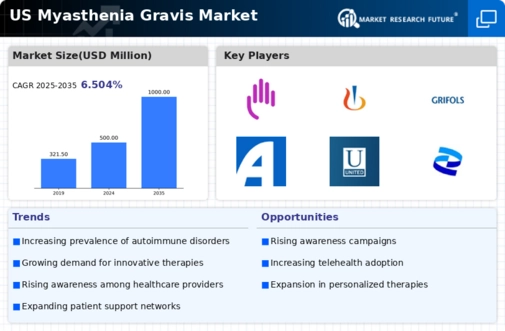Rising Incidence of Myasthenia Gravis
The myasthenia gravis market is experiencing growth due to the rising incidence of the disease in the US. Recent estimates suggest that approximately 20 per 100,000 individuals are affected by myasthenia gravis, indicating a growing patient population. This increase in prevalence is likely to drive demand for effective treatment options and healthcare services. As more individuals are diagnosed, the myasthenia gravis market is expected to expand, with pharmaceutical companies focusing on developing innovative therapies. The need for comprehensive care and management strategies is becoming increasingly apparent, which may lead to enhanced investment in research and development. Furthermore, the rising incidence may also prompt healthcare providers to improve diagnostic capabilities, thereby facilitating earlier detection and intervention.
Advancements in Diagnostic Technologies
The myasthenia gravis market is benefiting from advancements in diagnostic technologies that enhance the accuracy and speed of disease identification. Innovative techniques, such as high-throughput screening and advanced imaging modalities, are being integrated into clinical practice. These developments enable healthcare professionals to diagnose myasthenia gravis more effectively, which is crucial for timely treatment initiation. As diagnostic capabilities improve, the myasthenia gravis market is likely to see an increase in patient referrals and treatment uptake. Moreover, the integration of artificial intelligence in diagnostic processes may further streamline patient management, leading to better outcomes. The growing emphasis on precision medicine also aligns with these advancements, as accurate diagnosis is essential for tailoring individualized treatment plans.
Regulatory Support for Innovative Therapies
The myasthenia gravis market is benefiting from regulatory support aimed at expediting the approval of innovative therapies. Regulatory agencies in the US are increasingly adopting frameworks that facilitate faster access to new treatments for patients with unmet medical needs. This supportive environment encourages pharmaceutical companies to invest in the development of novel therapies for myasthenia gravis, which may lead to a broader range of treatment options. The myasthenia gravis market is likely to see a surge in product approvals, as regulatory bodies prioritize patient access to effective therapies. Additionally, the emphasis on expedited review processes may foster competition among manufacturers, potentially driving down costs and improving accessibility for patients. This regulatory landscape is crucial for the ongoing evolution of the myasthenia gravis market.
Growing Support from Patient Advocacy Groups
The myasthenia gravis market is positively influenced by the growing support from patient advocacy groups that raise awareness and promote research initiatives. These organizations play a crucial role in educating patients and healthcare providers about the disease, thereby increasing the likelihood of early diagnosis and treatment. Their efforts to advocate for funding and resources are vital for advancing the myasthenia gravis market. Additionally, these groups often collaborate with researchers and pharmaceutical companies to facilitate clinical trials and patient engagement. As the visibility of myasthenia gravis increases, it may lead to a more informed patient population, which could drive demand for therapies and support services. The collective efforts of these advocacy groups are likely to enhance the overall landscape of care for individuals affected by myasthenia gravis.
Increased Investment in Research and Development
The myasthenia gravis market is witnessing increased investment in research and development (R&D) from both public and private sectors. Funding for clinical trials and innovative treatment modalities is on the rise, as stakeholders recognize the unmet needs within the myasthenia gravis market. This influx of capital is likely to accelerate the development of novel therapies, including biologics and gene therapies, which may offer more effective treatment options for patients. Furthermore, collaborations between academic institutions and pharmaceutical companies are becoming more common, fostering an environment conducive to innovation. As R&D efforts intensify, the myasthenia gravis market is expected to evolve, potentially leading to breakthroughs that could transform patient care and management.

















Leave a Comment